If you’ve ever read the tiny print on the side of lipstick packaging, and you don’t have a chemistry degree, you’ve probably felt your eyes glaze over at the list of chemicals. Are these ingredients safe and eco-friendly, or downright toxic to you and the environment? As always, it’s a mixed bag for conventional cosmetics.
These days, I’m far more likely to pout about the greenwashing afoot in the cosmetics industry than to actually use lipstick to create the perfect pout. But, as with so many things for LeafScore, my research into this topic has me excited about lipstick again! Why? Because I found some gorgeous, truly non-toxic natural lipsticks from super sustainable, eco-friendly, safety-minded folks.
What to watch out for in lipstick
Most conventional lipsticks contain petroleum-derived chemicals, potentially toxic FD&C and lake dyes, synthetic ‘fragrance’ and preservatives, and other ingredients that may have adverse health effects. Indeed, the US Food and Drug Administration bans certain ingredients from use in lip products because of the increased risk of ingestion compared to, say, an eyeshadow or blush.
Let’s quickly go through some of the key chemicals to watch out for in lipsticks and how to spot them.
Talc
Similar in composition to asbestos, and a known carcinogen, talc is often used as a base in cosmetics. Companies like Ecco Bella have replaced talc with a mixture of natural clays and minerals, cornstarch, and flower wax-coated pigments.
FD&C and D&C colors
Derived from bituminous coal (coal tar), these colors can be carcinogenic and are tested on animals. Some are more toxic than others, so if you’re going to choose a lipstick containing these, check every color number with the Environmental Working Group first.
Propanediol
Propanediol is found in many lipsticks and may cause irritation in some sensitive folks but isn’t toxic to humans or the environment. So, avoid if you’re concerned you’re sensitive to this chemical, but don’t worry too much otherwise.
Pentylene glycol
Pentylene glycol is a synthetic, low molecular weight solvent and skin-conditioning agent. It hasn’t been associated with any adverse health effects in humans, but very little study has been done on this ingredient.
Sucrose acetate isobutyrate
This chemical has been linked to liver toxicity in rats, but a human study found no ill effects when volunteers ingested 20 mg per kg of body weight per day for two weeks. A 2016 review by the European Food Safety Agency (EFSA) concluded that oral absorption is approximately 70% in rats, about 50% in dogs and ≥ 88% in humans, and that SAIB as used as a food additive (or, presumably, in similar levels in cosmetics) is not a safety concern. All in all, I’d avoid this chemical where possible but not worry all that much about very minor exposure.
Titanium dioxide
This is a naturally occurring mineral found in the Earth’s crust. It is white, opaque, and can refract light and filter ultraviolet light, making it a popular ingredient in lipsticks. I’d avoid pressed powders that contain titanium dioxide as it is potentially carcinogenic when inhaled. In lipsticks, though, it does not appear to present a health hazard. Avoid formulation with nanoparticle titanium dioxide, however, as these may increase the risk of health effects.
As always, you’ll want to avoid the following:
- Parabens
- Phthalates
- Mineral oils
- Synthetic fragrances
- Synthetic preservatives
Look for natural preservatives in lipstick, such as vitamin E, beeswax, citric acid, and potassium sorbate.
Other considerations for eco-friendly lipstick
Glitter
Typically made of dyed or aluminum-plated microplastic polyethylene terephthalate, glitter is small enough to pass through water filtration systems and contaminate rivers, lakes, oceans, and other waterways, where it becomes a major problem for aquatic organisms, birds, and other animals.
Glitter and other microplastics can also act as a vehicle for bacteria, and there are numerous toxic chemicals in plastics, including phthalates and other endocrine disruptors. While glitter isn’t all that common in most lipsticks, if you are looking for a little glam, choose a product that shimmers thanks to eco-friendly seaweed-based glitter or mica.
Mica
While not necessarily toxic in itself, the extraction of mica, a shimmery substance, is linked to child labor, poor working conditions and deaths, as well as environmental pollution. As you’ll see below, I favor companies with a transparent policy on ethical sourcing of mica and have contacted other companies to ask about their stance on mica.
Our top picks
These days it’s easier than ever to replace your classic red lippy or a daring purple with a safe, non-toxic lipstick that can last all day without smudging, bleeding, or fading. You can read about our unique research process here.
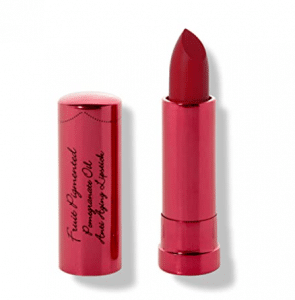
100% Pure Fruit Pigmented® Pomegranate Oil Anti Aging Lipstick
Highlights: USA-made, fruit pigmented, all-natural, cruelty-free, and vegan-friendly lipsticks that are actually good for your skin!
100% Pure Fruit Pigmented® Pomegranate Oil Anti-Aging Lipsticks sound too good to be true, but they’re both true and good for you! Made with pomegranate oil and shea butter, these lipsticks help keep your lips soft and moisturized and are colored with vibrant pigments from fruits like plums, raspberries, and grapes, as well as cocoa. These pigments are antioxidant-rich and may help protect the sensitive skin of your lips from free radical damage, hence the anti-aging claim. Also, pomegranate oil is naturally rich in compounds that support collagen production. Win win!
Offering full coverage and a satin finish, 100% Pure Lipsticks glide on easily, almost like a lip gloss. No dragging or need to warm the lipstick first. They come in a wide range of colors that last all day, including vivid fuchsia Marrakesh and more subtle Cassia and Mirage. I’m pretty smitten with Poppy and Hibiscus.
100% Pure are an environmentally responsible company that takes its pledge to be 100% pure seriously. They only use ingredients composed of “plant, mineral, and/or marine vegetation that undergoes chemical changes due to biological processes such as fermentation, distillation, and cold processing.” So, no parabens, phthalates, or potentially toxic FD&C colors or heavy metal dyes.
They’re also committed to remaining certified cruelty-free across their whole product range and the company works with a huge number of partners on sustainability and social justice initiatives worldwide. Right now, they’ll even donate either a meal for a shelter dog, or a tree through Trees for the Future with every purchase; your choice, and at no cost to you.
What else? Oh, they power their HQ with solar power, installed EV charging stations for staff, and use post-consumer recycled glass, plastic, tin, and paper to create packaging that can itself be recycled and that’s printed with non-toxic soy and vegetable inks.
Ingredients
Butyrospermum Parkii (Shea Butter), Punica Granatum (Pomegranate) Seed Oil, Theobroma Cacao (Cocoa) Seed Butter, Extracts of Prunus Cerasus (Cherry) Fruit, Prunus Domestica (Plum) Fruit, Vitis Vinifera (Cabernet Grape) Fruit, Rubus Idaeus (Raspberry) Fruit, Vaccinium Angustifolium (Blueberry) Fruit, Rubus Fruticosus (Blackberry) Fruit, Prunus Persica (Peach) Fruit, Prunus Armeniaca (Apricot) Fruit, Solanum Lycopersicum (Tomato) Fruit/Leaf/Stem, Punica Granatum (Pomegranate), Cacao (Chocolate), Rosa Centifolia (Rose Petals) Flower, Lavandula Angustifolia (Lavender) Flower/Leaf/Stem, Theobroma Cacao (Cocoa) Powder, Tocopherol (Vitamin E), Sodium Ascorbate (Vitamin C), Euphorbia Cerifera (Candelilla) Wax, Rosmarinus Officinalis (Rosemary) Leaf Extract.
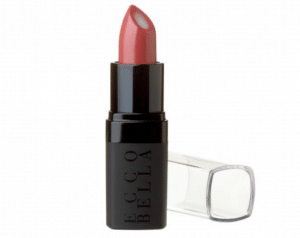
Ecco Bella FlowerColor Lipstick
Highlights: Eco-friendly and non-toxic high performing lipsticks from a well-loved US brand, but sadly not all colors are vegan.
Ecco Bella are one of the most well-known natural lipstick brands around, having been in the business since 1992. Their FlowerColor Lipsticks (View Price on Amazon) are free from gluten, toxic dyes, talc, alcohol, lanolin, tallow, parabens, phthalates, and FD&C colors and are tinted with flower wax-coated iron oxides and, in some cases, carmine (a pigment from crushed bugs). As such, not all of their lipsticks are vegan-friendly, though they say they’re actively looking for an alternative to this pigment. In the meantime, avoid the pink and purple lipsticks if you’re vegan.
Ecco Bella lipsticks are made without animal testing, however, and are a delightful mixture of natural oils, vegetable waxes, and mineral pigments. They moisturize your lips and don’t flake or chap. Still, it’s good to exfoliate lightly and moisturize first with most lipsticks, natural or not.
The company sources ingredients from ethical organic growers in the USA wherever possible, make almost all their products in the USA, and push for better conditions and higher standards within the cosmetics industry. Their lipsticks have been tested for lead, cadmium, and mercury and found to contain negligible amounts, lower even than those allowed in candy.
Ingredients
Castor oil, isopropyl palmitate (from palm oil), candelilla wax, 100iu Vitamin E, calendula oil*, chamomile oil*, jojoba oil*, flower wax-coated iron oxides. Pink and purple Lipstick colors may contain carmine. *Certified organic.
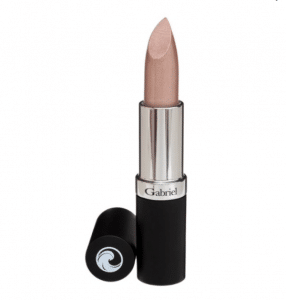
Gabriel Cosmetics Inc. Lipstick
Highlights: High-quality, vegan-friendly, all-natural lipsticks from a consistently fantastic eco-friendly brand.
Gabriel Cosmetics make vegan-friendly, cruelty-free, gluten-free, natural lipsticks (View Price on Walmart) in cream and shimmer finishes that provide long-lasting color. They go on smooth and help moisturize lips thanks to a mixture of jojoba oil, aloe vera, Candelilla wax, and bisabolol (from chamomile flowers).
Gabriel Organics Skincare began in 1992, making organic, non-toxic skincare products. The founder then created Zuzu Luxe as a non-toxic cosmetics line and acquired Clean Kids Naturally, to become Gabriel Cosmetics Inc.
The company prides itself on making safe and sustainable, eco-friendly, vegan-friendly cosmetics and skincare products and also partners with TerraCycle to help customers recycle product packaging. Indeed, return any 5 eligible Gabriel Cosmetics Inc. containers and you can get a free lipstick of your choice! Packaging is free from BPA, phthalates, dioxins, cadmium, and lead, and Gabriel use biodegradable packaging peanuts and other eco-friendly packaging materials. They also note that they use only fair trade mica (though this isn’t certified).
My one note of caution with Gabriel Cosmetics lipsticks is that they contain St. John’s Wort, which can make skin more sensitive to UV light. So, consider using an SPF lip primer or gloss alongside this lipstick, especially in summer.
Ingredients (representative sample)
Simmondsia Chinensis (Jojoba) Seed Oil, Euphorbia Cerifera (Candelilla) Wax, Caprylic/Capric Triglyceride, Sesamum Indicum (Sesame) Seed Oil, Carthamus Tinctorius (Safflower) Seed Oil, Tocopheryl Acetate, Lecithin, Crithmum Maritimum (Sea Fennel) Extract, Bisabolol, Aloe Barbadensis Leaf Extract, Iron Oxides, Mica, Hypericum Perforatum (St. John’s Wort) Extract, Titanium Dioxide.
Ingredients may change or vary occasionally.
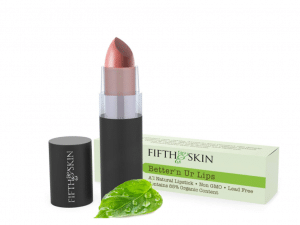
Fifth & Skin (formerly Skin2Spirit) Better’n Ur Lips Vegan Lipsticks
Highlights: 100% natural, 85% organic, totally vegan, eco-friendly, and non-toxic luscious lipsticks.
Fifth & Skin (formerly Skin2Spirit) make fantastic vegan-friendly lipsticks from all-natural, mostly (around 85%) organic ingredients (View Price on Amazon). They’re free from artificial preservatives, gluten, talc, GMOs, parabens, and lead, and are not tested on animals. Make sure to go for their Better’n Ur Lips line (which is vegan and 100% natural. Their original line, Botanical, is 95% natural and only vegetarian. (If in doubt, look for the Better’n Ur Lips semi-clear tube.)
I love their Berry Red, which works with pretty much every skin tone thanks to the slight blue tint. All of the Better’n Ur Lips lipsticks are made with organic butters and oils, botanical extracts, and essential plant oils that help moisturize your lips and offer antioxidant nutrients. They provide natural, vibrant, long lasting colors for 4 hours or more, depending on how you treat your lips of course.
As with so many cosmetics companies, Fifth & Skin lipsticks may contain mica but don’t have a stated policy about ethical sourcing of this mineral. I’ve reached out to ask about this and may bump up their leaf score to 5/5 depending on the answer.
Ingredients
*Castor Seed Oil, * Coconut Oil, * (Carnauba) Wax, *Glycerin, Candelilla Wax, * Cocoa Seed Butter, *Jojoba Seed Oil, Mango Butter, * Avocado, Cupuacu Butter, Vitamin E, *Grape Seed Oil, *Vanilla, * Oregano Leaf Extract, Thyme Extract, *Cinnamon Bark, * Rosemary Leaf Extract, Lavender Flower Extract, Goldenseal Root Extract, May Contain: Mica, Titanium Dioxide (Ci 77891), Iron Oxide (Ci 77491, 77492 77499) *Certified Organic.
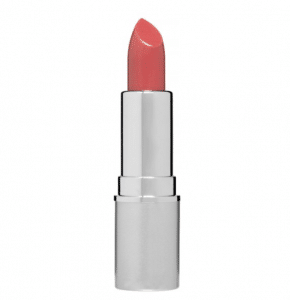
Honeybee Gardens Truly Natural Lipstick
Highlights: Affordable, vegan, and cruelty-free, mostly non-toxic, all-natural lipsticks made by a women-owned, champion company for the Campaign for Safe Cosmetics.
Honeybee Gardens are often a top Leaf Score pick for eco-friendly cosmetics as they offer top quality cosmetics that are eco-friendly and non-toxic. Their lipstick collection (View Price on Walmart) is no exception, with all the coverage of a lipstick and all the moisturizing of a lip balm. These lipsticks go on smooth, provide long-lasting color, and are more affordable than most competitors.
Honeybee Gardens lipsticks are made with certified organic ingredients such as sunflower seed oil, cocoa butter, and sesame oil, as well as vitamin E.
Unfortunately, some shades, including the Cherokee color, contain CI 45410, which was flagged for further attention by the Canadian Environmental Protection Agency (CEPA) for suspected aquatic toxicity, persistence, and bioaccumulation.
All of the cosmetics made by Honeybee Gardens are 100% gluten-free and many are certified gluten-free by the Gluten Intolerance Group, with plans to certify the rest of their range. Their cosmetics are also free of nanosized particles, so no need to worry about the titanium dioxide pigments, for instance.
They source their mica as ethically as possible in partnership with the National Resources Stewardship Council (NRSC), with most coming from the USA. They also send out batch samples regularly for third-party testing to ensure products are free from heavy metal contaminants and other contaminants (and they state that they’ve never had a batch flagged as problematic).
Most Honeybee Gardens products are made in the USA, in Pennsylvania and California, but some are made in Canada, Germany, or Italy.
Not sure which color to choose? Check out the Honeybee Gardens Lipstick Sampler, featuring real slices of the actual tube lipstick, so you get a real sense of the color over a few uses before you commit to your favorite(s!).
Ingredients
Ricinus Communis (Castor) Seed Oil*, Sesamum Indicum (Sesame) Seed Oil*, Helianthus Annuus (Sunflower) Seed Oil *, Euphorbia Cerifera (Candelilla) Wax, Copernicia Cerifera (Carnauba) Wax*, Trioctyldodecyl Citrate, Theobroma Cacao (Cocoa) Seed Butter*, Thymus Vulgaris (Thyme) Oil*, D-Alpha Tocopherol, Sodium Hyaluronate, Ethylhexylglycerin, Phenethyl Alcohol. May Contain: Mica, Titanium Dioxide (CI77891), CI77491, CI77492, CI77499, CI 45410. * = certified organic ingredients
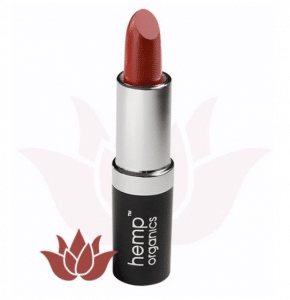
Hemp Organics Lipstick
Highlights: All-natural lipstick with 95% organic ingredients, but not vegan
Hemp Organics Lipstick (View Price on Walmart), made by Colorganics, is made with around 95% certified organic ingredients, is free from petrochemicals, fragrances, synthetic preservatives, FD&C dyes, gluten, parabens, and nanoparticles. The lipsticks are made with non-toxic mineral pigments and range from providing full coverage to a sheer finish.
Despite marketing claims on the websites of some stockists, none of the 32 or so Hemp Organics Lipstick shades are vegan-friendly as they all contain beeswax. If you’re more beegan than vegan, it might be useful to know that the colors that contain carmine include: Red Shine, Rose Petal, Wild Plum, Red Zin, Garnet, Scarlet fire, Crimson and Coral. Check the ingredients for each individual lipstick to be sure.
Hemp Organics don’t appear to have a policy around fair trade sourcing of mica. I’ve reached out to ask them about this and may upgrade to 5/5 leaves depending on the response. In the meantime, you may want to avoid any of the shimmery lipsticks if this is a concern for you.
Ingredients
Certified organic castor oil, certified organic beeswax, certified organic carnauba wax, certified organic hemp seed oil, certified organic jojoba oil, natural Non-GMO vitamin E (Sunflower Oil). May contain mica, iron oxides, carmine, titanium dioxide.
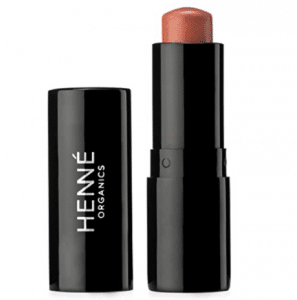
Henné Organic Luxury Natural Lip Tint
Highlights: All-natural, 88% organic, but not vegan-friendly lip tint in four subtle shades
Henné Organics Lip Tints (View Price on Amazon) go on sheer but can be layered to build a bolder look. They’re based on organic coconut and avocado oil and are great for moisturizing your lips and adding a pop of color.
Available in Intrigue, Bare, Azalea, and Coral, these minimalist lip tints are made in the USA and aren’t tested on animals. The founder of Henné Organics was inspired to create the first lip products after experiencing dry lips upon moving to the desert in Arizona. So, if you’re suffering similarly, check out their lip balms too!
Ingredients
Organic cocos nucifera (coconut) oil, organic ricinus communis (castor) seed oil, organic simmondsia chinensis (jojoba) seed oil, organic cera alba (beeswax), organic persea americana (avocado) oil, euphorbia cerifera (candelilla) wax, titanium dioxide, iron oxide, tocopherol (vitamin e).
88% organic.
Final thoughts: Is that lipstick vegan?
There are also several ingredients that pop up in lipsticks that aren’t typically detrimental to human health but aren’t vegan. These include:
- Cochineal – from crushed insects
- Pearl and guanine – made from fish scales and skin
- Carmine – from crushed bugs
- Beeswax (cera alba) – harvesting can compromise hive health
Hi, this is very helpful indeed. I was looking for a good lipstick for myself as I have sensitive skin. I loved the way you have described it. Got another article on similar line here -. Thank you guys for sharing.